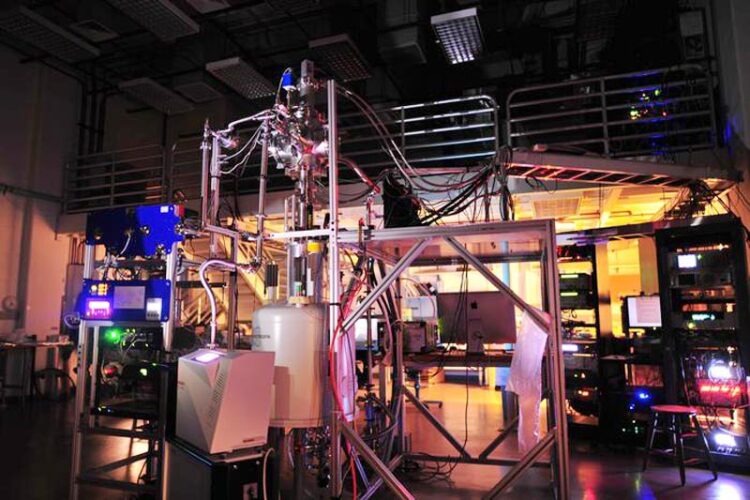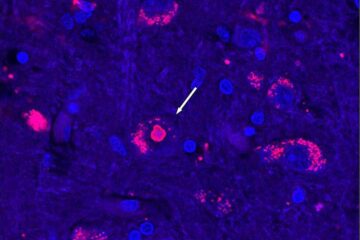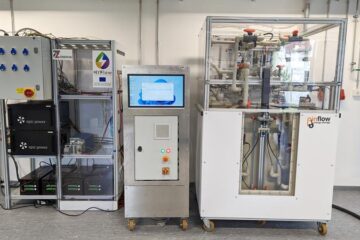Closing in on the Elusive Neutrino

Cyclotron Radiation Emission Spectroscopy (CRES), seen here, is the key to a totally new method that aims to pin down the mass of the elusive neutrino.
Credit: Alec Lindman, the Project 8 team
Project 8 marks a major milestone in its quest to measure neutrino mass.
The humble neutrino, an elusive subatomic particle that passes effortlessly through normal matter, plays an outsized role among the particles that comprise our universe. To fully explain how our universe came to be, we need to know its mass. But, like so many of us, it avoids being weighed.
Now, an international team of researchers from the United States and Germany leading an ambitious quest called Project 8 reports that their distinctive strategy is a realistic contender to be the first to measure the neutrino mass. Once fully scaled up, Project 8 could help reveal how neutrinos influenced the early evolution of the universe as we know it.
In 2022, the KATRIN research team set an upper bound for how heavy the neutrino could possibly be. That milestone was a tour-de-force accomplishment that has been decades in the making. But these results simply narrow the search window. KATRIN will soon reach and may one day even exceed its targeted detection limits, but the featherweight neutrino might be lighter still, begging the question: “what’s next?”
Tracing a ghost
In their most recent study, the Project 8 team reports in Physical Review Letters that they can use a brand-new technique to reliably track and record a natural occurrence called beta decay. Each event emits a tiny amount of energy when a rare radioactive variant of hydrogen—called tritium—decays into the three subatomic particles: a helium ion, an electron, and a neutrino.
The ultimate success of Project 8 hinges on an ambitious plan. Rather than try to detect the neutrino—which effortlessly passes through most detector technology—the research team has instead gone after a simple measurement strategy that can be summarized as follows:
We know the total mass of a tritium atom equals the energy of its parts, thanks to Einstein. When we measure a free electron generated by beta decay, and we know the total mass, the “missing” energy is the neutrino mass and motion.
“In principle, with technology developments and scale up, we have a realistic shot at getting into the range necessary to pin down the neutrino mass,” said Brent VanDevender, one of the principal investigators of Project 8 at the Department of Energy’s Pacific Northwest National Laboratory.
Why Project 8?
These researchers chose to go after an ambitious strategy because they have worked through the pros and cons and concluded that it could work.
Talia Weiss is a nuclear physics graduate student at Yale University. She and her Project 8 colleagues have spent years figuring out how to accurately tease out the electron signals from electronic background noise. Christine Claessens is a postdoctoral associate at the University of Washington who earned her Ph.D. on Project 8 at the University of Mainz, Germany. Weiss and Claessens performed the two final analyses that placed limits on the neutrino mass derived from the new technique for the first time.
“The neutrino is incredibly light,” said Weiss. “It’s more than 500,000 times lighter than an electron. So, when neutrinos and electrons are created at the same time, the neutrino mass has only a tiny effect on the electron’s motion. We want to see that small effect. So, we need a super precise method to measure how fast the electrons are zipping around.”
Project 8 relies on just such a technique, one conceived over a decade ago by physicists Joe Formaggio and Ben Monreal, then working at Massachusetts Institute of Technology. An international team rallied around the idea and formed Project 8 to convert the vision into a practical tool. The resulting method is called Cyclotron Radiation Emission Spectroscopy (CRES). It captures the microwave radiation emitted from newborn electrons as they spiral around in a magnetic field. These electrons carry away most—but not all—of the energy released during a beta decay event. It’s that missing energy that can reveal the neutrino mass. This is the first time that tritium beta decays have been measured, and an upper limit placed on the neutrino mass, with the CRES technique.
The team is only interested in tracking these electrons because their energy is key to revealing the neutrino mass. While this strategy has been used previously, the CRES detector measures that crucial electron energy with the potential to scale up beyond any existing technology. And that scalability is what sets Project 8 apart. Elise Novitski is an assistant professor at the University of Washington and has led many aspects of the newly published work.
“Nobody else is doing this,” Novitski said. “We’re not taking an existing technique and trying to tweak it a little bit. We’re kind of in the Wild West.”
In their most recent experiment, built at the University of Washington in Seattle, the team tracked 3,770 tritium beta decay events over an 82-day trial window in a sample cell the size of a single pea. The sample cell is cryogenically cooled and placed in a magnetic field that traps the emerging electrons long enough for the system’s recording antennas to register a microwave signal.
Crucially, the team registered zero false signals or background events that could be confused for the real thing. That’s important because even a very small background can obscure the signal of neutrino mass making interpretation of useful signal more difficult.
From chirps to signals
A subset of Project 8 researchers, led by PNNL experimental physicist Noah Oblath, but involving a dozen others across multiple institutions, have also developed a suite of specialized software—each delightfully named after various insects***—to take the raw data and convert them to signals that can be analyzed. And project engineers have put their tinkering hats on to invent the various parts that make Project 8 come together.
“We do have engineers who are crucial to the effort,” Novitski said. “It’s kind of out there from an engineer’s point of view. Experimental physics is kind of at the boundary of physics and engineering. You have to get particularly adventuresome engineers and practical-minded physicists to collaborate, make these things come into being because this stuff is not in the textbooks.”
Getting to the finish line
Now that the team has shown their design and experimental system works using molecules of tritium, they have another pressing task ahead. A subset of the full team is now working on the next step: a system that will produce, cool and trap individual atoms of tritium. This step is tricky because tritium, like its more abundant cousin hydrogen, prefers to form molecules. Those molecules would make the ultimate goals of the Project 8 team unachievable. The researchers, led by physicists at the University of Mainz, are developing a testbed to create and trap atomic tritium with intricate arrays of magnets that will keep it from even touching the walls of the sample cell—where it is almost certain to revert to molecular form.
This technology advance, and scaling up the whole apparatus, will be the critical steps to reaching and ultimately exceeding the sensitivity achieved by the KATRIN team.
For now, the research team, which has contributing members from ten research institutions, is working on testing designs for scaling up the experiment from the pea-size sample chamber to one a thousand times larger. The idea there is to capture a lot more beta decay events using a bigger listening device—going from the size of a pea to a beachball.
“Project 8 is not only a bigger and better CRES experiment, it is the first CRES experiment and was the very first to ever use this detection technique,” Oblath said. “It had never been done before. Most experiments have a 50- or 100-year history, at least of the detection technique that they’re using, whereas this is really brand new.”
It takes a village
Each Project 8 team investigator brings complementary skills to the group effort. A full list of collaborators can be found on the Project 8 web site.
Project 8 is supported by the U.S. Department of Energy Office of Science, Office of Nuclear Physics, the National Science Foundation, the German Research Foundation PRISMA+ Cluster of Excellence, and internal investments by all collaborating institutions.
***The software suite specially developed by investigators working on Project 8 includes Morpho, Locust, Katydid, Psyllid, and Dragonfly.
Journal: Physical Review Letters
DOI: 10.1103/PhysRevLett.131.102502
Method of Research: Experimental study
Subject of Research: Not applicable
Article Title: Tritium Beta Spectrum Measurement and Neutrino Mass Limit from Cyclotron Radiation Emission Spectroscopy
Article Publication Date: 6-Sep-2023
Media Contact
Karyn Hede
DOE/Pacific Northwest National Laboratory
karyn.hede@pnnl.gov
Office: 509-375-2144
Original Source
All latest news from the category: Physics and Astronomy
This area deals with the fundamental laws and building blocks of nature and how they interact, the properties and the behavior of matter, and research into space and time and their structures.
innovations-report provides in-depth reports and articles on subjects such as astrophysics, laser technologies, nuclear, quantum, particle and solid-state physics, nanotechnologies, planetary research and findings (Mars, Venus) and developments related to the Hubble Telescope.
Newest articles

After 25 years, researchers uncover genetic cause of rare neurological disease
Some families call it a trial of faith. Others just call it a curse. The progressive neurological disease known as spinocerebellar ataxia 4 (SCA4) is a rare condition, but its…

Lower dose of mpox vaccine is safe
… and generates six-week antibody response equivalent to standard regimen. Study highlights need for defined markers of mpox immunity to inform public health use. A dose-sparing intradermal mpox vaccination regimen…

Efficient, sustainable and cost-effective hybrid energy storage system for modern power grids
EU project HyFlow: Over three years of research, the consortium of the EU project HyFlow has successfully developed a highly efficient, sustainable, and cost-effective hybrid energy storage system (HESS) that…





















